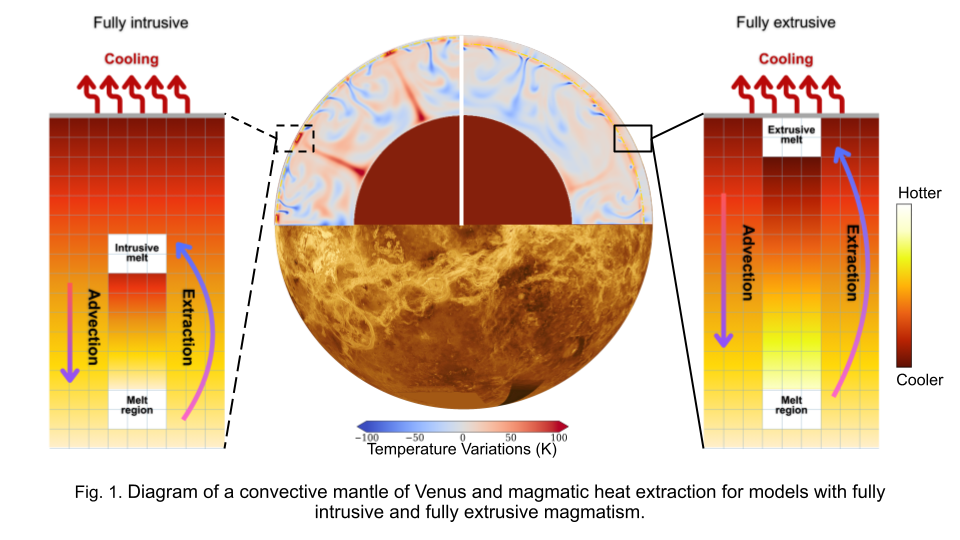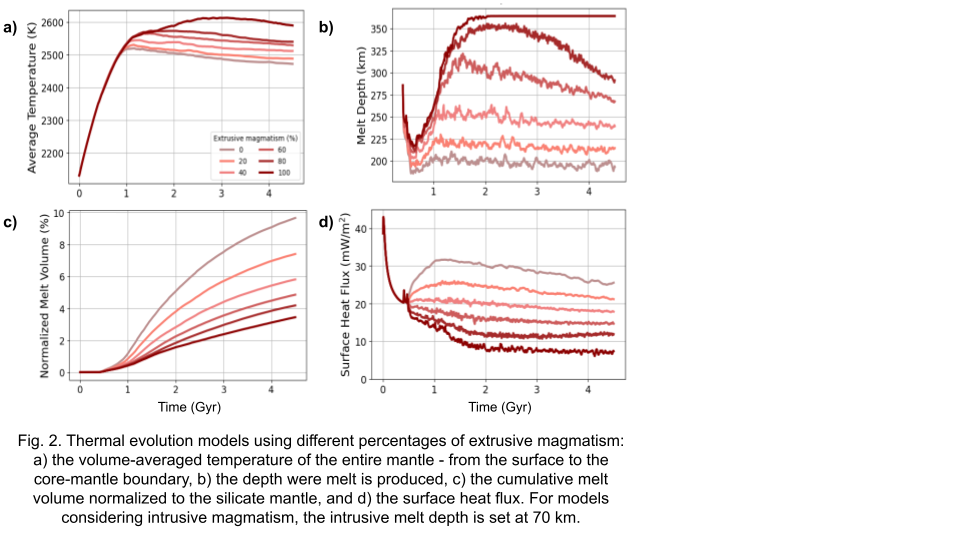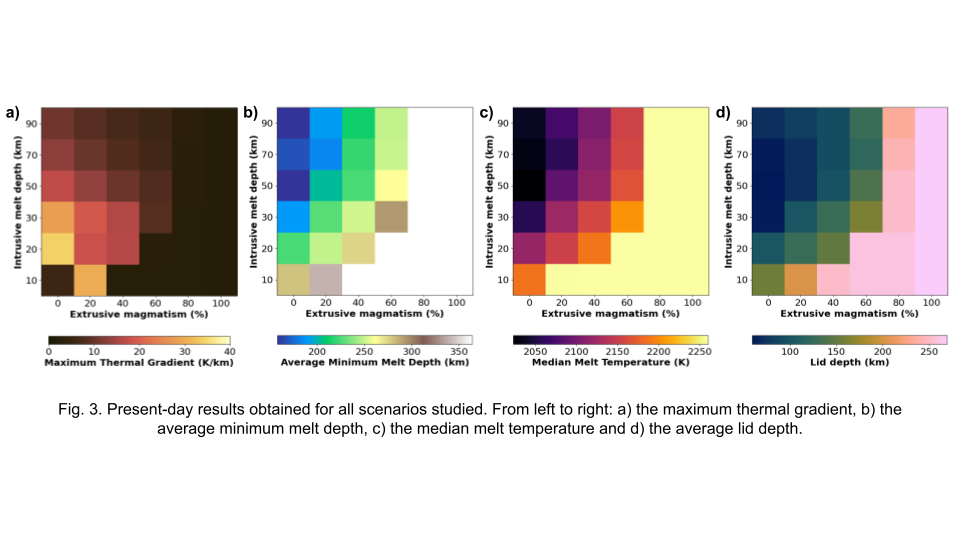Effects of intrusive magmatism on the thermal evolution and present-day state of Venus
- 1German Aerospace Center (DLR), Institute of Planetary Research, Germany (carianna.herrera@dlr.de)
- 2University of Münster (WWU), Institute of Mineralogy, Münster, Germany
ABSTRACT
Recent analysis of NASA’s Magellan radar data revealed that magmatic activity is ongoing on Venus. The geodynamic regime is, however, poorly constrained. Many scenarios have been proposed to explain Venus’ evolution being one of them the “plutonic-squishy” lid regime, which involves the presence of magmatic intrusions. We investigate the effects of magmatic intrusions on mantle’s thermal evolution and the present-day thermal state of the interior. We vary the percentage of extrusive magmatism and compare our results to available geophysical constraints to select successful models. Our findings support recent observations of a magmatically active planet, with Venus being primarily governed by highly intrusive magmatic processes.
INTRODUCTION
A recent study examined synthetic aperture radar data from NASA’s Magellan mission and identified a volcanic vent that changed shape in the 8-month interval between two radar images, which was interpreted as a sign of ongoing volcanic activity on Venus [1]. Moreover, the large number of volcanoes recently compiled in a global catalog [2] indicate that the planet’s evolution and present-day state has been dominated by volcanic processes.
Venus’s geodynamic regime and surface tectonics are, however, poorly constrained and several scenarios including catastrophic resurfacing, episodic plate tectonics, and the “plutonic-squishy lid” regime were proposed [3]. This last one, which has been suggested to be representative for the tectonic regime on early Earth [4], considers that part of the melt that formed in the interior rises to the surface but a significant part remains trapped in the crust and lithosphere as magmatic intrusions.
Here, we investigate effects of intrusive magmatism on the evolution and present-day state of Venus. We evaluate our models by comparing our present-day constraints based on studies of the elastic lithosphere thickness [5,6,7] and interior viscosity of Venus [8].
METHODS
We use the geodynamic code GAIA in a 2D spherical annulus geometry [9,10]. The viscosity is temperature- and depth-dependent, following an Arrhenius law [11]. The thermal conductivity and thermal expansivity in our models are also pressure- and temperature-dependent [12]. We assume a homogeneous distribution of the heat sources and account for the decay in time of radioactive elements (i.e. 238U, 235U, 232Th, and 40K) and for core cooling.
Melting occurs when the temperature of the mantle rocks is higher than the solidus, for which we assume similar values as proposed for the Earth’s interior [13]. We model that the melt can reach the surface (extrusive magmatism), but also that part of this melt can remain trapped in the crust and lithosphere (intrusive magmatism). Fig.1 shows the melt treatment in our models for fully extrusive and fully intrusive cases. We vary the extrusive melt between 0% (fully intrusive) and 100% (fully extrusive) in steps of 20%, and we vary it between 10km and 90km in steps of 20km.

RESULTS
Our results show that magmatic intrusions affect the temperature, viscosity, and velocity across the mantle. The intrusive cases have more vigorous convection than the fully extrusive one and larger temperature variations in the convecting mantle with clearly distinguishable mantle plumes (Fig.1). Moreover, the intrusive melt depth seems to control the growth of the stagnant lid: the more intrusive magmatism, the thinner the lid is (Fig.3d).
On average, Venus models with highly intrusive magmatism are characterized by a cooler interior, produce more melt at shallower depths and colder temperatures, and have higher thermal gradients, and consequently higher surface heat fluxes during their entire evolution (Fig.2).

At present day, our models show that depending on the percentage of extrusive melt and the depth of magmatic intrusions, the maximum thermal gradient varies from a few K/km up to almost 40K/km, with higher values obtained for higher percentages of intrusive melt and shallower magmatic intrusions (Fig.3a). Models in which the extrusive magmatism is higher than 60% and the depth of magmatic intrusions lies deeper than 50km cannot explain high local thermal gradients as suggested by studies of elastic lithosphere thickness [5,6,7].
In a recent study [8], the presence of a low viscosity layer (LVL) in the shallow Venusian mantle has been suggested to be related to the presence of partial melt. The LVL starts beneath the lithosphere at depths shallower than 200km. This places constraints on the depth of melting that we can use to select successful models. Models that are compatible with partial melting starting at a depth of 200km or less beneath the surface require <40% extrusive magmatism and magmatic intrusions located strictly deeper than 10km (Fig.3b).
Regarding the melt properties, the distinction between intrusive and extrusive cases starts very early in the evolution. Cases that have fully extrusive magmatism present hotter melt and melt deeper than the cases with some percentage of intrusions (Fig.3c). The fully extrusive cases produce partial melt as deep as ~11GPa, the pressure at which melt is more compressible than the solid silicate matrix, and becomes denser which prevents it from rising to the surface [14]. We do not consider this deep melt in our simulation since do not contribute to the magmatic processes investigated here.

SUMMARY
Our analyses indicate that magmatic processes play a major role in the interior evolution of Venus. Our models that are compatible with available geophysical constraints support the scenario of a magmatically active Venus, primarily governed by highly intrusive magmatism and is compatible with the plutonic-squishy lid regime.
The melt depth and melt temperature estimations will be used to inform high-pressure-high-temperature laboratory experiments that will be carried out at the University of Münster to investigate the mantle compositions of Venus that explain the Venera and Vega data (Jennings et al., this meeting).
REFERENCES
[1] Herrick & Hensley, Science, 2023; [2] Rolf et al., SSR, 2023; [3] Hahn & Byrne, JGR, 2023; [4] Lourenco et al., G3, 2020; [5] Borelli et al., JGR, 2021; [6] Maia et al., JGR, 2022; [7] Smrekar et al., Nat.Geoscience, 2023; [8] Maia et al., GRL, 2023; [9] Hüttig et al., PEPI, 2013; [10] Fleury et al., G3 2024.; [11] Karato et al., Philosophical Magazine, 2003; [12] Tosi et al., PEPI, 2013.; [13] Stixrude et al., EPSL, 2009; [14] Ohtani et al., Chem.Geol., 1995.
How to cite: Herrera, C., Plesa, A.-C., Maia, J., Jennings, L., and Klemme, S.: Effects of intrusive magmatism on the thermal evolution and present-day state of Venus, Europlanet Science Congress 2024, Berlin, Germany, 8–13 Sep 2024, EPSC2024-666, https://doi.org/10.5194/epsc2024-666, 2024.